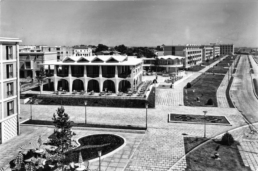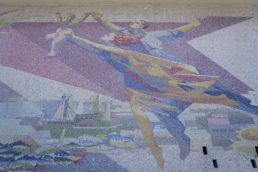In 1948, the Communist government of the Romanian People’s Republic adopted a labour code that granted paid holidays for all workers.
Soon after, architects were put to work as the government commissioned a string of seaside resorts along the Black Sea coast, where comrades could spend their state-allotted holiday vouchers.
South of the port city of Constanta, a constellation of cosmically-named resorts can still be found today, dotted along the shores, towards the town of Mangalia.

While the resorts of Neptun-Olimp, Saturn, Venus and Jupiter are home to many standardised tower blocks, there are a number of notable architectural sites in the area.
Olimp
Olimp is dominated by a trio of modernist hotels — Panoramic, Amfiteatru and Belvedere. They were completed in 1972 under the guidance of architect Aron Solari-Grimberg, who was also responsible for Ceaușescu’s contrastingly extravagant Spring Palace.
Landscaping played a key role in the design of the complex. Staggering on a slope that faces the Black Sea, the concept sought inspiration from amphitheatres. The three link together in a semicircle, creating an open space in the middle, that allows scenic views onto the beach from the hotel rooms, as well as the large pool area.

One of the largest of its kind along the coast, the complex is home to some 1,542 hotel rooms. The number of floors climbs up to six at Amfiteatru, which is wedged in the middle, while the others have four, with the ground level carved into the rock.
Today, a room can be booked at Belvedere, however the other two remain closed. Meanwhile surrounding amenities such as a bowling hall and a restaurant are abandoned and sealed off. While the entrances to the hotels remain chained shut, inside you can see the modernist decorative artworks and lighting installations that have remained since the communist period.

Neptun
The development of Neptun, located further south of Olimp, began slightly earlier in 1962 and officially entered the tourist circuit in 1967. Among the buildings are Hotel Neptun, a stand-out structure decked in bare concrete, wood panels and forest-green mosaic walls.
The hotel is half-abandoned, and retains many of its original fittings— from the typography that directs to the different areas, to abstract wall decorations.
Although there is a faint sign of construction work (demolished chunks of concrete could be found in the garden while building tools were scattered on the floor inside), the security guard at the desk seems largely unbothered by visitors who wander in.
Other sites include the tropical-looking Hotel Caraman, and Hotel Decebal, which accommodates a well-maintained modular design that makes up its decorative facade.

Mangalia
The port of Mangalia is anchored on the shores of the coast further south of the resorts. The town is built on the ruins of the ancient Greek city of Callatis, which was a prosperous hub, thanks to its strategic military positioning and access to the sea. Occupied by the Romans, Bulgarians and Turks, Mangalia’s architectural landscape presents a distinct mix.
Communist high-rises, early-modernist buildings, newly-built neo-classical structures and one of the oldest mosques in the country, lie within a few hundred feet of each other.
The House of Culture features a 300ft-long mural called ‘Geneze’ (Genesis), which was designed by Jules Perahim and Mac Constantinescu. It is one of the largest murals in Eastern Europe and consists of 3.150.000 porcelain pieces that measure 2x2cm each.
The work connects natural elements of life: water, earth, air and the sun, as powering human existence, which is symbolised through the child thrust forth by a mother and father.
Although typically socialist realist in style, the work was allegedly criticised by dogmatists due to its lack of communist symbols (namely the hammer and sickle), instead drawing emphasis to the subject through its vibrant colours and sharp modernist style.
Following an investigation by the authorities, Jules Perahim assumed full responsibility for the work, and apparently suffered such repercussions that he left Romania, and emigrated to Israel.

It is also possible to catch a glimpse of work completed by Cezar Lăzărescu, a prolific architect who headed several projects in Bucharest including the airport, and reshaped many urban developments following the ’77 earthquake.
Perched on Mangalia’s shore lies his ‘Cazino’ complex, a modernist ensemble which was once a popular restaurant during the communist period.
Lăzărescu created several resorts around the Black Sea in Eforie and Mamaia, and played a pivotal role in shifting the party’s preference from socialist realist styles, instead implementing designs inspired by American, Nordic and Swiss schools of modernism.
He was highly sought-after by party officials who would recruit him to build luxury villas, and unlike Grimberg, he turned down the opportunity to build Ceaușescu a residence, due to ‘aesthetic incompatibility’.






